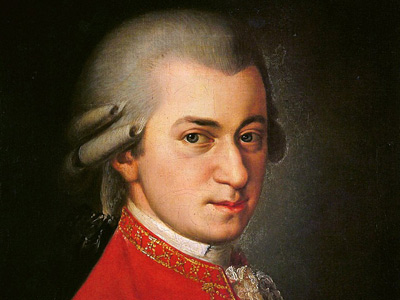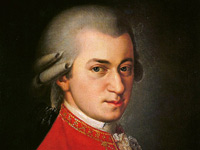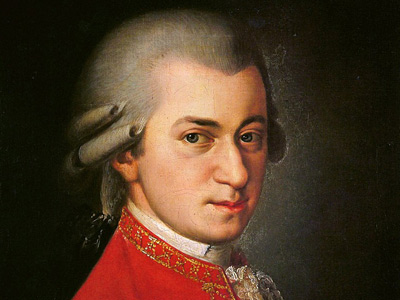Wolfgang Amadeus Mozart (1756-1791)

1782–1786
In the course of 1782 and 1783, Mozart became intimately acquainted with the work of Johann Sebastian Bach and George Frideric Handel as a result of the influence of Gottfried van Swieten, who owned many manuscripts of the Baroque masters. Mozart's study of these scores inspired compositions in Baroque style and later influenced his personal musical language, for example in fugal passages in Die Zauberflöte ("The Magic Flute") and the finale of Symphony No. 41.
In 1783, Mozart and his wife visited his family in Salzburg. His father and sister were cordially polite to Constanze, but the visit prompted the composition of one of Mozart's great liturgical pieces, the Mass in C minor. Though not completed, it was premiered in Salzburg, with Constanze singing a solo part.
Mozart met Joseph Haydn in Vienna around 1784, and the two composers became friends. When Haydn visited Vienna, they sometimes played together in an impromptu string quartet. Mozart's six quartets dedicated to Haydn (K. 387, K. 421, K. 428, K. 458, K. 464, and K. 465) date from the period 1782 to 1785, and are judged to be a response to Haydn's Opus 33 set from 1781. Haydn in 1785 told Mozart's father: "I tell you before God, and as an honest man, your son is the greatest composer known to me by person and repute, he has taste and what is more the greatest skill in composition."
From 1782 to 1785 Mozart mounted concerts with himself as soloist, presenting three or four new piano concertos in each season. Since space in the theaters was scarce, he booked unconventional venues: a large room in the Trattnerhof (an apartment building), and the ballroom of the Mehlgrube (a restaurant). The concerts were very popular, and the concertos he premiered at them are still firm fixtures in the repertoire. Solomon writes that during this period Mozart created "a harmonious connection between an eager composer-performer and a delighted audience, which was given the opportunity of witnessing the transformation and perfection of a major musical genre".
With substantial returns from his concerts and elsewhere, Mozart and his wife adopted a rather plush lifestyle. They moved to an expensive apartment, with a yearly rent of 460 florins. Mozart bought a fine fortepiano from Anton Walter for about 900 florins, and a billiard table for about 300. The Mozarts sent their son Karl Thomas to an expensive boarding school, and kept servants. Saving was therefore impossible, and the short period of financial success did nothing to soften the hardship the Mozarts were later to experience.
On 14 December 1784, Mozart became a Freemason, admitted to the lodge Zur Wohltätigkeit ("Beneficence"). Freemasonry played an important role in the remainder of Mozart's life: he attended meetings, a number of his friends were Masons, and on various occasions he composed Masonic music, e.g. the Maurerische Trauermusik.
HISTORY

RESOURCES
This article uses material from the Wikipedia article "Wolfgang Amadeus Mozart", which is released under the Creative Commons Attribution-Share-Alike License 3.0.
© Stories Preschool. All Rights Reserved.









